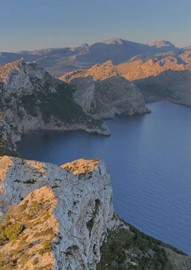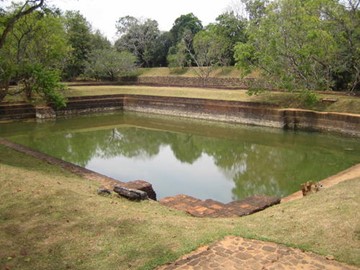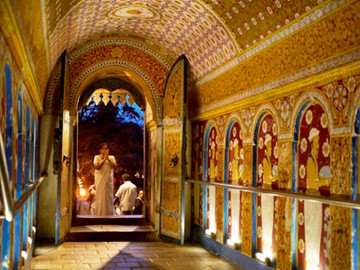category :: cultural
San Cristóbal de La Laguna
San Cristóbal de La Laguna, a UNESCO World Heritage site in Spain, is a historic city founded in the late 15th century, renowned for its well-preserved colonial architecture and urban layout. It served as a model for many colonial cities in the Americas, featuring a grid pattern with vibrant streets, churches, and convents. The city’s cultural significance is highlighted by its rich history as the former capital of Tenerife and its blend of European and indigenous influences. Today, it stands as a testament... Read More
Palmeral of Elche
The Palmeral of Elche, a UNESCO World Heritage site in Spain, is a remarkable historic landscape featuring an extensive grove of date palms. Established during the Islamic period between the 7th and 10th centuries, it showcases an intricate irrigation system that has sustained the palm groves for centuries, reflecting advanced agricultural practices of the time. This oasis-like setting also includes traditional huertos (garden plots) and is celebrated for its cultural and botanical significance, offering a ... Read More
Roman Walls of Lugo
The Roman Walls of Lugo, a UNESCO World Heritage site in Spain, are an exceptionally well-preserved example of Roman military architecture from the 3rd century AD. Constructed under Emperor Augustus, these fortifications stretch over 2 kilometers, featuring 85 semicircular towers and multiple gates, built with slate and granite. Originally designed to protect the Roman city of Lucus Augusti, the walls remain largely intact, offering a unique glimpse into ancient engineering and urban planning. Today, they s... Read More
Vall de Boí
Vall de Boí, a UNESCO World Heritage site in Spain, is renowned for its exceptional collection of Romanesque churches dating back to the 11th and 12th centuries. These well-preserved structures, including notable examples like Sant Climent de Taüll and Santa Maria de Taüll, showcase stunning architecture and intricate frescoes that reflect the region's medieval cultural and religious significance. The site’s historical importance and artistic value make it a remarkable testament to Catalonia’s Romanesque he... Read More
Atapuerca
The Archaeological Site of Atapuerca, a UNESCO World Heritage site in Spain, is renowned for its exceptional prehistoric findings, offering critical insights into early human evolution. Excavations have uncovered fossils and tools dating back over a million years, including remains of some of the earliest known hominins in Western Europe. The site's well-preserved evidence has significantly advanced scientific understanding of human ancestry and prehistoric life.
Aranjuez
The Aranjuez Cultural Landscape, a UNESCO World Heritage site, is a remarkable example of a human-shaped environment blending nature and culture. It features an intricate network of historic gardens, orchards, and waterways, alongside elegant palaces and architectural treasures, reflecting centuries of royal influence and innovative land management. This harmonious fusion of Baroque and Renaissance styles with the surrounding natural beauty showcases a unique legacy of artistic and environmental planning. I... Read More
Vizcaya Bridge
The Vizcaya Bridge, a UNESCO World Heritage site in Spain, is an iconic transporter bridge completed in 1893, designed by architect Alberto de Palacio. It stands as a remarkable feat of industrial engineering, blending iron construction with innovative technology to ferry passengers and vehicles across the river via a suspended gondola. Recognized for its historical and architectural significance, it symbolizes the ingenuity of the late 19th century and remains operational today.
Altamira Cave
Altamira Cave, a UNESCO World Heritage site in Spain, is renowned for its prehistoric rock art, dating back to the Upper Paleolithic period, approximately 36,000 to 13,000 years ago. Discovered in 1868, the cave features remarkable polychrome paintings and engravings of bison, horses, and other animals, created using charcoal, ochre, and natural contours of the rock. Often called the 'Sistine Chapel of Prehistoric Art,' it provides invaluable insight into early human creativity and culture. Due to preservat... Read More
Ávila
The Old Town of Ávila, a UNESCO World Heritage site in Spain, is renowned for its well-preserved medieval architecture, including its iconic city walls constructed in the 11th century. These walls, featuring 88 towers and nine gates, encircle a historic center filled with Romanesque and Gothic churches, such as the Ávila Cathedral, begun in 1091. The site reflects a blend of military, religious, and cultural influences, showcasing Spain’s rich historical legacy. Its significance lies in its exemplary urban ... Read More
Tower of Hercules
The Tower of Hercules is an ancient Roman lighthouse and UNESCO World Heritage site, recognized for its historical and architectural significance. Built in the 1st century AD, it stands as the oldest functioning lighthouse in the world, originally constructed to guide ships along the Atlantic coast. Its robust stone structure, later renovated in the 18th century, blends Roman engineering with neoclassical design, symbolizing centuries of maritime heritage. Today, it serves as both a navigational aid and a c... Read More
Palau de la Música Catalana
The Palau de la Música Catalana and Hospital de Sant Pau are two UNESCO World Heritage sites in Spain, celebrated for their architectural brilliance and cultural significance. The Palau, designed by Lluís Domènech i Montaner, is a stunning concert hall known for its intricate modernist design, featuring vibrant stained glass and ornate details. Nearby, the Hospital de Sant Pau, also by Domènech i Montaner, showcases a unique blend of functionality and artistry with its decorative pavilions and gardens. Toge... Read More
Seville
The Cathedral, Alcázar, and Archivo de Indias in Seville form a UNESCO World Heritage site renowned for their historical and architectural significance. The Cathedral, a grand Gothic masterpiece, houses the tomb of Christopher Columbus and features the iconic Giralda tower. Adjacent to it, the Alcázar, a stunning royal palace, showcases Mudéjar architecture with intricate tilework and lush gardens. Nearby, the Archivo de Indias preserves invaluable documents from Spain’s colonial era, reflecting its maritim... Read More
Serra de Tramuntana
The Cultural Landscape of the Serra de Tramuntana, a UNESCO World Heritage site in Spain, is a stunning example of human adaptation to a rugged mountainous environment. This unique region showcases an intricate network of terraces, stone walls, and water management systems developed over centuries, primarily for olive and vineyard cultivation. Its historical significance lies in the blend of Islamic and Christian agricultural traditions, reflecting a harmonious coexistence with nature. The site’s picturesqu... Read More
Routes of Santiago de Compostela: Camino Francés and Northern Spain
The Routes of Santiago de Compostela, recognized as a UNESCO World Heritage site, encompass the Camino Francés and other historic pilgrimage paths leading to the shrine of St. James in Santiago de Compostela. These routes, traveled by pilgrims since the Middle Ages, are celebrated for their cultural and historical significance, featuring a network of trails dotted with churches, monasteries, and hostels. The Camino Francés, the most famous route, highlights the architectural and spiritual legacy of this end... Read More
Burgos Cathedral
Burgos Cathedral, a UNESCO World Heritage site in Spain, is a stunning Gothic masterpiece begun in 1221 and completed over centuries. Its intricate facade, adorned with spires and sculptures, showcases exceptional architectural artistry. The cathedral houses notable treasures, including the tomb of El Cid and a golden staircase by Diego de Siloé. Renowned for its historical and cultural significance, it remains a prominent symbol of Spanish heritage.
Antequera Dolmens Site
The Antequera Dolmens Site, a UNESCO World Heritage site in Spain, comprises three prehistoric megalithic monuments: the Menga Dolmen, Viera Dolmen, and Tholos of El Romeral. Dating back to the Neolithic and Bronze Age periods, these structures showcase exceptional engineering and architectural skills of ancient communities, built using large stone blocks. The site also includes two natural monuments, La Peña de los Enamorados and El Torcal, which enhance its cultural and historical significance. Recognized... Read More
Segovia
The Old Town of Segovia and its Aqueduct, a UNESCO World Heritage site in Spain, is a remarkably preserved historic ensemble showcasing Roman engineering and medieval architecture. The iconic Roman aqueduct, constructed in the 1st century AD, stands as one of the best-preserved structures of its kind, channeling water across a dramatic stone-arched span. Complementing this, the Old Town features a picturesque blend of Gothic and Renaissance buildings, including a stunning cathedral and a fairy-tale-like alc... Read More
Mudejar Architecture of Aragon
Mudejar Architecture of Aragon, a UNESCO World Heritage site, exemplifies a unique blend of Islamic and Christian artistic traditions from the 12th to 17th centuries. This style features intricate brickwork, horseshoe arches, and ornate stucco work, reflecting the cultural coexistence of Muslim, Christian, and Jewish communities. Notable examples include churches and towers that showcase this hybrid aesthetic, preserved as a testament to medieval craftsmanship and historical harmony.
Cáceres
The Old Town of Cáceres, a UNESCO World Heritage site in Spain, is a remarkably preserved medieval ensemble featuring a blend of Roman, Islamic, Gothic, and Renaissance architecture. Its historic core boasts narrow cobblestone streets, ancient stone walls, and notable landmarks like the Santa María Cathedral and the Torre de Bujaco, reflecting centuries of cultural influences. This well-maintained urban landscape offers a glimpse into Spain’s rich historical past, attracting visitors with its timeless charm... Read More
Medina Azahara
Medina Azahara, a UNESCO World Heritage site in Spain, is a remarkably preserved 10th-century palace-city built by the Umayyad Caliph Abd al-Rahman III. Constructed as a symbol of power and grandeur, it features intricate architecture, including ornate stucco work, horseshoe arches, and expansive courtyards. Abandoned after less than a century, the site offers a unique glimpse into the sophistication of Islamic civilization in Al-Andalus. Today, it stands as a testament to the region’s rich historical and c... Read More
Anuradhapura
Anuradhapura, a UNESCO World Heritage site in Sri Lanka, is an ancient city renowned for its historical and cultural significance. Founded in the 4th century BCE, it served as the island's first capital and a major center of Buddhism, featuring impressive stupas, monasteries, and the sacred Sri Maha Bodhi tree, grown from a cutting of the tree under which Buddha attained enlightenment. The site also showcases advanced ancient engineering through its well-preserved irrigation systems and reservoirs. Today, i... Read More
Polonnaruwa
Polonnaruwa, a UNESCO World Heritage site in Sri Lanka, is an ancient city renowned for its well-preserved ruins and historical significance as a medieval capital. Established in the 11th century, it features impressive architectural remains, including royal palaces, temples, monasteries, and intricately carved statues, such as the famous Gal Vihara rock reliefs. The site also showcases advanced irrigation systems, reflecting the engineering prowess of its time. Today, it stands as a testament to Sri Lanka’... Read More
Sigiriya
Sigiriya, a UNESCO World Heritage site in Sri Lanka, is an ancient rock fortress renowned for its historical and architectural significance. Built in the 5th century by King Kashyapa, it features a massive rock column rising dramatically from the surrounding landscape, topped with a palace complex. The site is famous for its well-preserved frescoes, intricate water gardens, and the iconic Lion Gate, reflecting advanced engineering and artistic mastery of the era. Today, it stands as a testament to Sri Lanka... Read More
Kandy
Kandy, a UNESCO World Heritage site in Sri Lanka, is a historic city renowned for its cultural and spiritual significance. It served as the last capital of the Sinhala kings, preserving a rich legacy of traditions and architecture. The city is home to the Temple of the Tooth Relic, one of Buddhism's most sacred shrines, housing a tooth of the Buddha. Kandy's vibrant festivals, notably the Esala Perahera, attract visitors with their elaborate processions and ancient rituals.
Galle
The Old Town of Galle, a UNESCO World Heritage site in Sri Lanka, is a well-preserved colonial fortress showcasing a blend of European and South Asian architectural influences. Built by the Portuguese in the 16th century and later expanded by the Dutch, it features sturdy ramparts, historic buildings, and charming streets that reflect its rich past as a key trading port. Today, it stands as a living testament to the island's colonial history, attracting visitors with its cultural significance and scenic coa... Read More
























